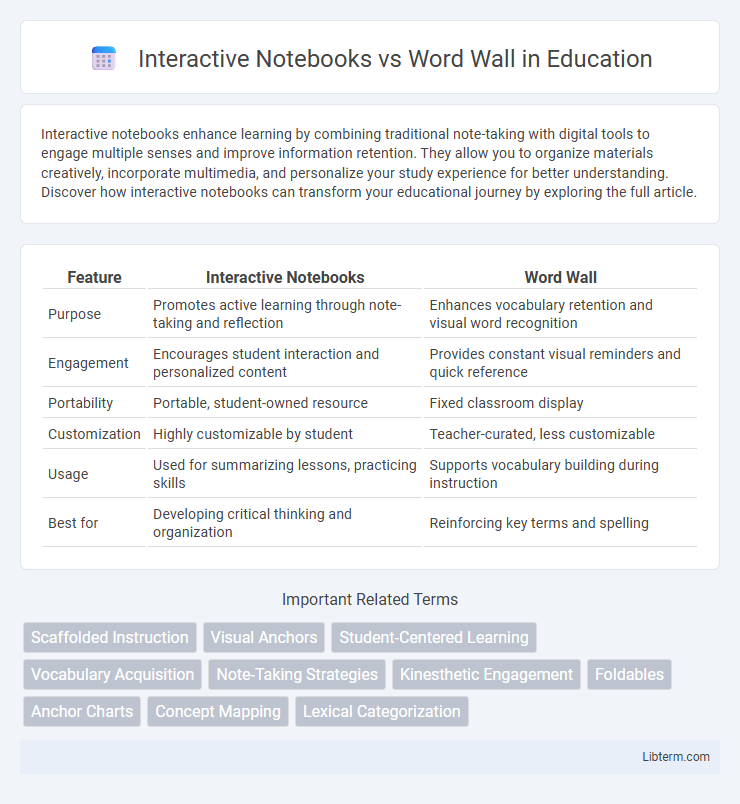Interactive notebooks enhance learning by combining traditional note-taking with digital tools to engage multiple senses and improve information retention. They allow you to organize materials creatively, incorporate multimedia, and personalize your study experience for better understanding. Discover how interactive notebooks can transform your educational journey by exploring the full article.
Table of Comparison
| Feature | Interactive Notebooks | Word Wall |
|---|---|---|
| Purpose | Promotes active learning through note-taking and reflection | Enhances vocabulary retention and visual word recognition |
| Engagement | Encourages student interaction and personalized content | Provides constant visual reminders and quick reference |
| Portability | Portable, student-owned resource | Fixed classroom display |
| Customization | Highly customizable by student | Teacher-curated, less customizable |
| Usage | Used for summarizing lessons, practicing skills | Supports vocabulary building during instruction |
| Best for | Developing critical thinking and organization | Reinforcing key terms and spelling |
Introduction to Interactive Notebooks and Word Walls
Interactive Notebooks offer a dynamic platform for students to engage in personalized learning by organizing notes, reflections, and graphic organizers, enhancing comprehension and retention. Word Walls provide a visual reference that supports vocabulary development and spelling by displaying key terms and concepts prominently in the classroom. Both tools foster active learning environments but serve different pedagogical purposes, with Interactive Notebooks emphasizing individualized input and Word Walls focusing on collective word recognition.
Defining Interactive Notebooks
Interactive Notebooks are personalized, student-centered learning tools that combine input and output activities to enhance comprehension and retention. They integrate notes, reflections, and multimedia elements within a structured format, encouraging active engagement and critical thinking. This method contrasts with Word Walls, which primarily serve as visual vocabulary aids to support word recognition and language development.
Understanding Word Walls
Word Walls enhance vocabulary retention by visually organizing key terms in a classroom, allowing students to interact with words through frequent exposure and contextual use. Interactive Notebooks engage students by encouraging personalized note-taking and reflection, which supports deeper cognitive processing but lacks the constant visual presence of Word Walls. Understanding Word Walls involves recognizing their role in reinforcing word recognition and spelling through consistent display, making them an effective tool for language acquisition and literacy development.
Key Benefits of Interactive Notebooks
Interactive notebooks enhance student engagement through hands-on activities that promote active learning and personalized organization of content. They support deeper comprehension by allowing students to integrate text, visuals, and reflections, fostering critical thinking skills. Unlike Word Walls, which mainly reinforce vocabulary, interactive notebooks provide a comprehensive tool for capturing, processing, and reviewing diverse subject matter dynamically.
Advantages of Word Walls in the Classroom
Word Walls enhance vocabulary retention by providing a constant visual reference, supporting students' spelling and word recognition skills. They promote interactive learning through student engagement, helping to reinforce key concepts and language patterns. Easily adaptable to different subjects and grade levels, Word Walls foster collaborative classroom environments and encourage active participation.
Differences in Student Engagement
Interactive notebooks promote individualized student engagement by allowing hands-on, creative note-taking and personalized content organization, which enhances active participation and retention. Word walls encourage collective engagement through visual exposure and collaborative reference, supporting vocabulary development and group interaction. The primary difference lies in interactive notebooks fostering self-directed learning, while word walls emphasize communal learning experiences.
Classroom Implementation Strategies
Interactive notebooks promote active learning through student-generated content and personalized organization, fostering deeper engagement with material. Word walls enhance vocabulary acquisition by providing a dynamic, visible reference, supporting frequent review and collaborative activities. Effective classroom implementation integrates both tools by encouraging students to use word walls as a resource when creating interactive notebook entries, reinforcing retention and application.
Assessment and Learning Outcomes
Interactive Notebooks enhance assessment by allowing personalized student reflections and continuous formative evaluation, promoting deeper understanding and retention of content. Word Walls support learning outcomes by reinforcing vocabulary acquisition and fostering visual memory, which aids in language development and subject comprehension. Combining both tools creates a balanced approach to assessment that captures both conceptual progress and language mastery.
Choosing the Right Tool for Your Classroom
Interactive Notebooks foster active student engagement by allowing personalized note-taking and hands-on learning, making them ideal for developing critical thinking and reflection skills. Word Walls provide a visual and repetitive word reference that supports vocabulary retention and literacy, perfect for younger students or language learners. Selecting the right tool depends on your classroom goals: choose Interactive Notebooks for deep concept exploration and critical analysis, or Word Walls to reinforce vocabulary and support reading fluency.
Conclusion: Interactive Notebooks vs Word Wall
Interactive notebooks foster personalized learning by allowing students to organize and reflect on content dynamically, enhancing retention and critical thinking skills. Word walls, as a visual aid, support vocabulary acquisition and quick recall through constant exposure but may lack depth in cognitive engagement. Choosing between interactive notebooks and word walls depends on educational goals, with notebooks better suited for active synthesis and word walls optimal for reinforcing key terminology.
Interactive Notebooks Infographic

 libterm.com
libterm.com